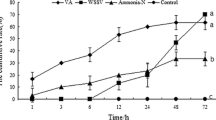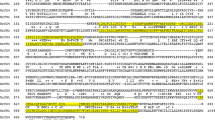Abstract
We isolated and characterized the profilin (FcPFN) cDNA from hemocytes ofFenneropenaeus chinensis, a unique shrimp species from the Yellow Sea. The FcPFN cDNA consists of 830 bp and encodes a polypeptide of 125 amino acids, having a predicted isoelectric point of 5.06. The deduced amino acid sequence of FcPFN shows 36% and 90% amino acid sequence identity to the profilin genes of Pacific white shrimpLitopenaeus vannamei and black tiger shrimpPenaeus monodon, respectively. The FcPFN mRNA was highly expressed in hemocytes and hepatopancreas and moderately in muscle of normal shrimp. The higher expression of FcPFN mRNA is observed in shrimp infected with the white spot syndrome virus (WSSV), which is a major concern in all shrimp-growing regions of the world. These results suggest a potential role for FcPFN in viral host defense mechanisms.
Similar content being viewed by others
References
Asahida T, Kobayashi T, Saitoh K, Nakayama I, 1996. Tissue preservation and total DNA extraction from fish stored at ambient temperature using buffers containing high concentration of urea. Fish Sci 62: 727–730.
Billadeau DD, Burkhardt JK, 2006. Regulation of cytoskeletal dynamics at the immune synapse: new stars join the actin troupe. Traffic 7: 1451–1460.
Birbach A, 2008. Profilin, a multi-modal regulator of neuronal plasticity. Bioessays 30: 994–1002.
Buss F, Temm-Grove C, Henning S, Jockusch BM, 1992. Distribution of profilin in fibroblasts correlates with the presence of highly dynamic actin filaments. Cell Motil Cytoskeleton 22: 51–61.
Clavero-Salas A, Sotelo-Mundo RR, Gollas-Galván T, Hernández-López J, Peregrino-Uriarte AB, Muhlia-Almazán A, Yepiz-Plascencia G, 2007. Transcriptome analysis of gills from the white shrimpLitopenaeus vannamei infected with White Spot Syndrome Virus. Fish Shellfish Immunol 23: 459–472.
Critchley DR, Holt MR, Barry ST, Priddle H, Hemmings L, Norman J, 1999. Integrin-mediated cell adhesion: the cytoskeletal connection. Biochem Soc Symp 65: 79–99.
Dong JH, Ying GX, Zhou CF, 2004. Entorhinal deafferentation induces the expression of profilin mRNA in the reactive microglial cells in the hippocampus. Glia 47: 102–108.
Flegel TW, 1997. Major viral diseases of the black tiger prawn (Penaeus monodon) in Thailand. World J Microbiol Biotechnol 13: 433–442.
Harris HE, Weeds AG, 1978. Platelet actin: sub-cellular distribution and association with profiling. FEBS Lett 90: 84–88.
Haugwitz M, Noegel AA, Karakesisoglou J, Schleicher M, 1994.Dictyostelium amoebae that lack G-actin-sequestering profilins show defects in F-actin content, cytokinesis, and development. Cell 79: 303–314.
Hussey PJ, Ketelaar T, Deeks MJ, 2006. Control of the actin cytoskeleton in plant cell growth. Annu Rev Plant Biol 57: 109–125.
Janke J, Schlüter K, Jandrig B, Theile M, Kölble K, Arnold W, et al. 2000. Suppression of tumorigenicity in breast cancer cells by the microfilament protein profilin 1. J Exp Med 191: 1675–1686.
Kimura T, Yamano K, Nakano H, Momoyama K, Hiraoka M, Inouye K, 1996. Detection of penaeid rod-shaped DNA virus (PRDV) by PCR. Fish Pathol 31: 93–98.
Lightner DV, 1996. A handbook of pathology and diagnostic procedures for diseases of penaeid shrimp. Special publication of the World Aquaculture Society, Baton Rouge, LA, USA.
Lo CF, Hsu HC, Tsai MF, Ho CH, Peng SE, Kou GH, Lightner DV, 1999. Specific genomic DNA fragment analysis of different geographical clinical samples of shrimp white spot syndrome virus. Dis Aquat Org 35: 175–185.
Magdolen V, Oechsner U, Muller G, Bandlow W, 1988. The intron-containing gene for yeast profilin (PFY) encodes a vital function. Mol Cell Biol 8: 5108–5115.
Park JH, Lee YS, Lee S, Lee Y, 1998. An infectious viral disease of penaeid shrimp newly found in Korea. Dis Aquat Org 34: 71–75.
Pearson AM, Baksa K, Rämet M M, Protas M, McKee M, Brown D, Ezekowitz RA, 2003. Identification of cytoskeletal regulatory proteins required for efficient phagocytosis inDrosophila. Microbes Infect. 5: 815–824.
Pollard TD, 2008. Progress towards understanding the mechanism of cytokinesis in fission yeast. Biochem Soc Trans. 36: 425–430.
Powell JWB, Burge EJ, Browdy CL, Shepard EF, 2006. Efficiency and sensitivity determination of Shrimple®, an immunochromatographic assay for white spot syndrome virus (WSSV) using quantitative real-time PCR. Aquaculture 257: 167–172.
Rawe VY, Payne C, Schatten G, 2006. Profilin and actin-related proteins regulate microfilament dynamics during early mammalian embryogenesis, Hum Reprod 21: 1143–1153.
Scheurer S, Wangorsch A, Nerkamp J, Skov PS, Ballmer-Weber B, Wüthrich B, et al. 2001. Cross-reactivity within the profilin panallergen family investigated by comparison of recombinant profilins from pear (Pyr c 4), cherry (Pru av 4) and celery (Api g 4) with birch pollen profilin Bet v 2. J. Chromatogr B. Biomed Sci 756: 315–325.
Smith LC, Britten RJ, Davidson EH, 1995. Lipopolysaccharide activates the sea urchin immune system. Dev Comp Immunol 19: 217–224.
Sohn RH, Goldschmidt-Clermont PJ, 1994. Profilin: at the crossroads of signal transduction and the actin cytoskeleton. Bioessays 16: 465–472.
Staiger CJ, Blanchoin L, 2006. Actin dynamics: Old friends with new stories. Curr Opin Plant Biol 9: 554–562.
Vemuri B, Singh SS, 2001. Protein kinase C isozyme-specific phosphorylation of profilin. Cell Signal 13: 433–439.
Verheyen EM, Cooley L, 1994. Profilin mutations disrupt multiple actin-dependent processes duringDrosophila development. Development 120: 717–728.
Witke W, 2004. The role of profilin complexes in cell motility and other cellular processes. Trends Cell Biol 14: 461–469.
Witke W, Podtelejnikov AV, Di Nardo A, Sutherland JD, Gurniak CB, Dotti C, Mann M, 1998. In mouse brain profilin I and profilin II associate with regulators of the endocytic pathway and actin assembly. EMBO J 17: 967–976.
Wittenmayer N, Jandrig B, Rothkegel M, Schlüter K, Arnold W, Haensch W, et al. 2004. Tumor suppressor activity of profilin requires a functional actin binding site. Mol Biol Cell 15: 1600–1608.
Yarovinsky F, Zhang D, Andersen JF, Bannenberg GL, Serhan CN, Hayden MS, et al. 2005. TLR11 activation of dendritic cells by a protozoan profilin-like protein. Science. 308: 1626–1629.
Author information
Authors and Affiliations
Corresponding author
Rights and permissions
About this article
Cite this article
Kong, H.J., Hong, G.E., Cho, H.K. et al. Cloning of profilin (FcPFN) from the shrimpFenneropenaeus chinensis, a highly expressed protein in white spot syndrome virus (WSSV)-infected shrimp. J Appl Genet 50, 245–250 (2009). https://doi.org/10.1007/BF03195678
Received:
Accepted:
Issue Date:
DOI: https://doi.org/10.1007/BF03195678




